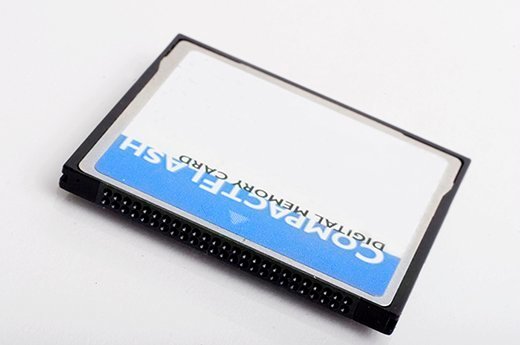What is a CompactFlash card (CF card)?
A CompactFlash card (CF card) is a memory card format developed by SanDisk in 1994 that uses flash memory technology to store data on a very small portable device. It has no moving mechanical parts and doesn't need a battery to retain data. Small memory cards let users add data to a variety of computing devices. CF cards today are primarily used as removable memory for high-end digital single-lens reflex (DSLR) and video cameras.
The original CompactFlash card was built using NOR flash memory. NOR flash has the advantage of being able to execute programs directly from flash without having to be copied in a device's system RAM. However, NAND is better suited for large amounts of data storage and became the default type of flash memory used in all removable memory cards, including the CompactFlash memory card and its primary competitor, the Secure Digital (SD) card.
Why are CF cards important and how are they used
Because flash is non-volatile memory (NVM), stored data is retained when the host device's power source is turned off or lost. A CF card features solid-state construction, which makes it more rugged than most traditional storage devices. The operating shock rating -- basically, the height a device can be dropped from and still work -- for a CF card is 2,000 gauss compared to a 100 G to 200 G rating for the mechanical hard disk drive of a typical portable computing device. This translates to a drop to the floor from 10 feet versus a single foot for the mechanical disk drive.
CompactFlash and CompactFlash Express (CFexpress) cards are used in professional imaging, DSLR cameras, camcorders, video and still image recorders, and similar devices. Higher-performing types of CF cards on the market are the CompactFast (CFast) and XQD cards. CF cards can be used in a PC card slot with a plug adapter. They can also be used as a storage device with a passive adapter or memory card reader.

CompactFlash Association and compliance
CF card manufacturers that are members of the CompactFlash Association can self-test their cards for interoperability. CFA was established in 1995 in Los Gatos, Calif. The group has 80 members and describes its primary focus as the professional digital camera and video recording markets, as well as the industrial market.
CFA has established three different CF levels:
- CF 4.1a. Products that are widely available at speeds up to 90 megabytes per second (MBps) sequential access speed.
- CF 5.0. Products that have more efficient commands and support TRIM operations, providing consistent speed.
- CF 6.0. Products that implement Ultra Direct Memory Access 7, which provides bus speeds up to 167 MBps and supports the Sanitize command.
CFA focuses on the development of current and future specifications, defines compliance requirements, promotes CompactFlash technology and functionality, identifies relevant use cases and supports compatibility across all CFA-defined products.
CF card advantages and limitations
CF cards are generally quite durable and can perform in extreme temperatures. They are smaller than solid-state drives and have high data transfer rates, meaning more data can be stored on a CF card in the same amount of time compared with SD and microSD cards.
On the negative side, CF cards often cost more than other types, but as always, it is essential to shop carefully and know the specific requirements. Data on CF devices may erode over time if they are disconnected from power supplies for too long.
CompactFlash technical specifications
Based on the Parallel Advanced Technology Attachment (ATA) interface, CF cards measure 42.8 millimeters by 36.4 mm -- about the size of a matchbook. They're available with storage capacities ranging up to 512 gigabytes.
CompactFlash cards support 3.3 volt and 5 V operation and can switch between the two. This is different from other small form factor flash memory, which can only operate at 1 V.
There are two types of CF cards, in varying thicknesses, to accommodate different capacities: Type I CF cards are 3.3 mm thick, and Type II cards are 5 mm thick. The extra thickness of Type II cards is because almost all of them are Microdrives, a 1-inch spinning hard drive format that IBM originally developed.
CompactFlash Express technical specifications
CFexpress is a more recent standard in which cards are based on the Peripheral Component Interconnect Express (PCIe) Gen 3 interface and use established NVM express (NVMe) protocols to offer better efficiency, as well as optimized power and performance, for professional imaging and video markets.
The CFexpress standard defines three form factors:
- Type A is 20 mm wide by 28 mm long by 2.8 mm thick, including label area.
- Type B is 38.5 mm wide by 29.6 mm long by 3.8 mm thick, including label area. Type B cards have the same dimensions and connector as XQD cards.
- Type C is 54 mm wide by 74 mm long by 4.8mm thick, including label area.
Two current releases of CFexpress are available:
- CFexpress 1.0 uses the NVMe 1.2 stack and is limited to the Type B form factor.
- CFexpress 2.0 uses the NVMe 1.3 stack and offers all three form factors.
CompactFast technical specifications
CFast cards support the most current CFast 2.0 specification and use the third-generation Serial ATA interface that supports bus speeds in excess of 600 megabits per second (Mbps). The previous CFast 1.1 specification supported bus speeds of 300 Mbps. The CFast 2.0 spec is used for industrial and professional imaging and video applications. A CFast card measures 36.4 mm by 42.8 mm by 3.6 mm.
XQD technical specifications
CFA's most recent removable flash memory card format, XQD, uses the faster PCIe Gen 1 interface and supports bus speeds up to 250 Mbps. An XQD card measures 29.6 mm by 38.5 mm by 3.8 mm.
XQD is considered an essential foundation specification for high-performing cards in the coming years, according to CFA.
CF card manufacturers
Over the years, other manufacturers, in addition to SanDisk, have entered the CompactFlash market, offering a variety of products. Companies must be a member of CFA to manufacture or market products using the CFA specification. The organization has a list of members on its website, including Western Digital SanDisk, Delkin Devices, Lexar and Transcend Information.
Flash memory is becoming increasingly important in consumer electronics. Learn everything you need to know about flash in our guide.







